Affiliate disclosure: This post may contain affiliate links. Please see our Privacy Policy.
Canning peaches is surprisingly easy to do at home. All you need is a few jars, a big pot, and a little sugar and you’re on your way. Home-canned peaches stored in glass mason jars also taste dramatically better than store-bought peaches in tin cans, and if you have your own peach tree, they’re almost free.
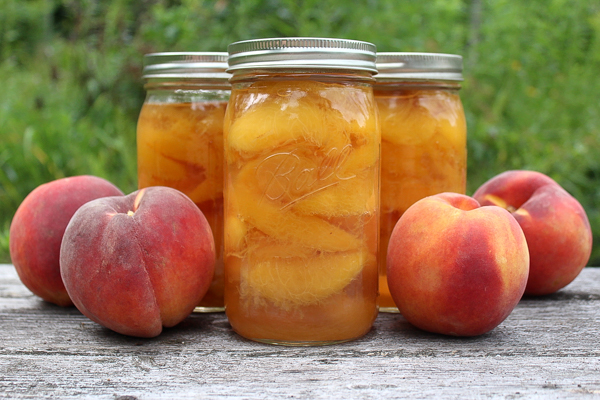
Table of Contents
We’re just getting in our first peach trees this year, and it’ll be a while until we have our own homegrown peaches. We’re in zone 4, and it’s hard to find peach varieties for cold climates. Plant breeders have been hard at work, and there are now several varieties that produce well in our area.
In the meantime, our local food coop imports Amish peaches from Pennsylvania by the caseload. Every year I buy a case and can up a big batch for wintertime peach cobbler.
Peaches, or more specifically, peach jam was the first thing I canned with a mentor in my youth. Call it a gateway fruit if you want, but I was hooked. My first batch was admittedly a bit lackluster.
I was a kid, and I got to choose how much sugar went into the batch. At that point in my life, more sugar made everything better and I just about ruined the batch. You could barely taste the fruit, and peach-colored candy is a better description of the results.
Fast forward a few decades and I still can’t handle over-sweetened canned goods, jam or otherwise. I use very light syrup when canning peaches, but there are plenty of choices based on your preferences.
Peach Varieties Safe for Canning
All known varieties of yellow-fleshed peaches are safe for water bath canning at home. No exceptions. White-fleshed peaches are another matter.
Scientists at the National Center for Home Food Preservation recently discovered that some varieties of white-flesh peaches may not be safe for canning. While yellow peaches are a high acid food, some varieties of white flesh peaches have a more delicate flavor and far less acidity. Fruits must have a pH below 4.6 to be safe for canning, and white-fleshed peaches may not quite make it.
There’s currently no tested safe method for canning white-fleshed peaches, but theoretically, they should be fine for canning using the same methods as other low acid fruits. Home-canned mangoes are one example of another low acid fruit that’s not acidic enough on its own, but it should, in theory, be safe with added lemon juice.
Pressure canning is also another option if you have a bumper crop of peaches. While you don’t need to pressure can yellow peaches, some people prefer to pressure can in general and there is an approved method.
Yellow peaches are pressure canned at 6 pounds of pressure for 10 minutes anywhere below 2,000 feet in elevation. White peaches would require either higher pressure to be safe, and that might just pulverize the tender fruit.
As always, if you’re canning at home, use your best judgment. If you have white peaches to preserve, the only approved method is freezing, so maybe skip the canner altogether to be on the safe side?
Choosing Peaches for Canning
Just about any yellow fleshed peach can be preserved by canning, but some will do better than others. Here are a few things to consider when choosing peaches for canning:
- Freestone or Clingstone – Most grocery store peaches are freestone these days, and the flesh comes away easily from the pit. Older varieties and backyard trees may be clingstone, which makes it nearly impossible to can peach halves. Clingstone peaches are a bit more work, but they often have amazing flavor in return, just plan on canning them as slices.
- Size – Larger peaches have more flesh per peach, and will save you quite a bit of time in peeling. If you’re planning on canning peach halves instead of slices, aim for small to medium-sized peaches so that the halves will fit in a jar.
- Ripeness – Very ripe peaches have soft flesh and are lower acid than firm peaches. Choose peaches that are just barely ripe. The flesh should still be firm but they’ve lost all the green around the stem. Just ripe peaches will hold together better, and result in a much better texture in your home-canned peaches.

Syrup for Canning Peaches
Peaches are quite sweet on their own, and the fact that they’re high acid means they can be water bath canned in just about any liquid. Plain water works, but will wash out the flavor. Fruit juice or very light syrup work better, since they’re about as sweet as the peaches and won’t leach any of the sugars from the peaches, and they won’t make them any sweeter either.
If you’re not up for a low sugar recipe, light and medium syrups work just fine too. Here’s how to make a number of different syrups for canning peaches:
- Water Pack – Simple enough, just make sure the water is boiling hot before it goes into the jars.
- Juice Pack – Fruit juices such as apple or white grape juice are a natural way to can peaches without refined sugar. Just like water pack, be sure that the juices are boiling hot when packing the jars.
- Very Light Syrup – This mimics the natural sugar content of peaches and will result in the most natural flavor. For a 9-pint canner load, use 3/4 cups sugar and 6 1/2 cups water. For a 7-quart canner load, add 1 1/4 cups sugar to 10 1/2 cups water.
- Light Syrup – For the most part, light syrup is used to add just a hint of sweetness to fruits that are very sweet already. Peaches are a great choice for light syrup, and that’s often how they’re packed in the grocery store. For a 9-pint canner load, use 1 1/2 cups sugar and 5 3/4 cups water. For a 7-quart canner load, add 2 1/4 cups sugar to 9 cups water.
- Medium Syrup – If you like your canned peaches really sweet, choose medium syrup. They’ll be pretty over the top, don’t say I didn’t warn you…For a 9-pint canner load, use 2 1/4 cups sugar and 5 1/4 cups water. For a 7-quart canner load, add 3 3/4 cups sugar to 8 1/4 cups water.
Canning Peaches with Honey or Maple
Since peaches can be canned in just about any liquid, the amount or type of sugar in the syrup doesn’t affect their safety. Honey canned peaches are a popular choice because the honey flavor complements the flavor of the peaches. We make our own maple on our Vermont homestead, so that’s an obvious choice for us.
Whether you’re using honey or maple to sweeten the canning syrup, use about 2/3rds as much as you would sugar. Honey and maple are both much sweeter than sugar, and you’ll need less volume to get the same amount of sweetness compared to white sugar.
For example, if you’re making a 9-pint canner batch of canned peaches with very light syrup, use 1/2 cup of honey instead of 3/4 cup of sugar added to 6 1/2 cups of water. Since the sugar level isn’t crucial to the safety of the canned peaches, feel free to approximate. Roughly 2/3rds will give you a similar level of sweetness, but there’s no need to be exact.
Hot Pack or Raw Pack Canning
There are two main ways to pack peaches for canning, or any fruit for that matter. Peaches are safe and approved for both methods, and they each have their pros and cons. While I raw pack my canned pineapple without issue, peaches aren’t as forgiving. Hot pack peaches make dramatically better quality canned peaches.
- Hot Pack Canned Peaches – Peaches are quickly boiled in their canning syrup to heat them and pre-cook them before canning. This drives off some of the air that’s naturally in the fruit’s tissues. Removing that extra air prevents the peaches from floating, and helps keep the canned peaches from browning over time. In many areas, this is the only method approved for entry into a state fair because the peaches retain their quality better over time, and they’re more attractive in the jar.
- Raw Pack Canned Peaches – For a raw pack, the peeled and pitted peaches are packed into jars raw. The canning liquid, usually syrup of some kind, is brought to a boil and poured over the raw peaches before the jars are sealed and processed in a water bath canner. It’s much easier to pack the jars since the fruit isn’t hot, and this is a good option if the peaches will be eaten in the next 2-3 months. If you’re storing raw pack peaches for longer periods of time they may brown or deteriorate. Even if they discolor, they’re still safe to eat for just as long as hot pack peaches.
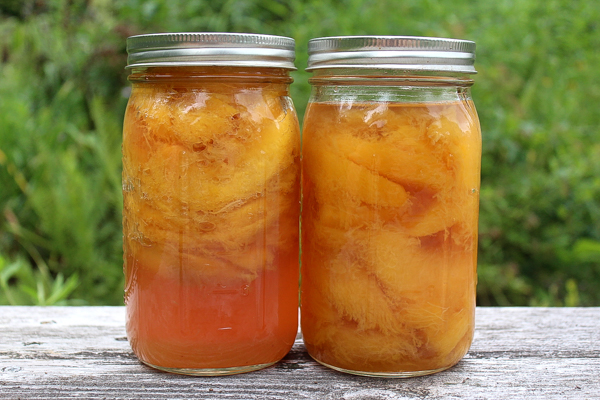
How Many Peaches Fit in a Canning Jar?
Obviously, the number of peaches that’ll fit in a canning jar varies based on how big the peaches are. Roughly speaking though, it takes around 17 to 18 pounds of peaches to make a 7-quart canner batch or around 10 to 12 pounds for a 9-pint canner batch. That works out to about 2-3 pounds per quart jar or 1 1/4 pounds per pint jar.
That said, if you’re canning halved peaches, slightly less will fit in a jar. Sliced peaches pack more densely in a canning jar, and you may be able to fit slightly more.
Regardless of how you’ve sliced the peaches, be sure to pack them into the jars as densely as you can. Peaches shrink during the canning process, and if you don’t really cram them into the jars you’ll end up with sad looking half-filled jars.
My giant farmhouse sink holds just over one canner load (7 quarts) worth of peaches, and I use that sink to cold water bath them after a quick blanching for peeling. This time I had gigantic peaches, so it took about 28 peaches or 4 huge peaches per jar. It’d take 5-6 average-sized peaches to fill a quart jar.
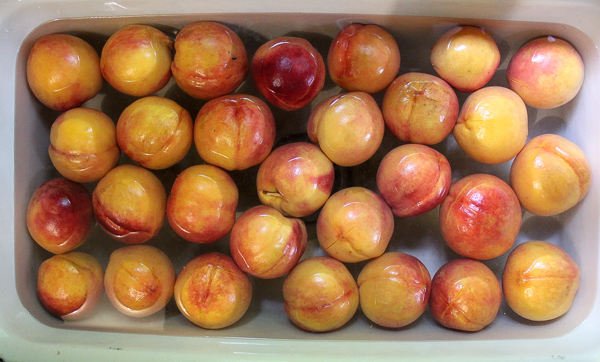
Peeling Peaches for Canning
The first step to canning peaches is removing their fuzzy skins. Bring a pot of water to a boil on the stove, and then dip each peach in the boiling water for 2-3 minutes. With very ripe peaches, it’ll take less time and firmer peaches require more cooking to peel.
If the peach skins just aren’t listening, try making a shallow X on the bottom of each peach with a sharp knife before placing the peach in boiling water. This will help the skin start to peel easier.
Scoop the peaches out of the boiling water with a slotted spoon and drop them into a sink or bowl full of ice water. Once they’re cool, the skins should remove easily with your fingers.
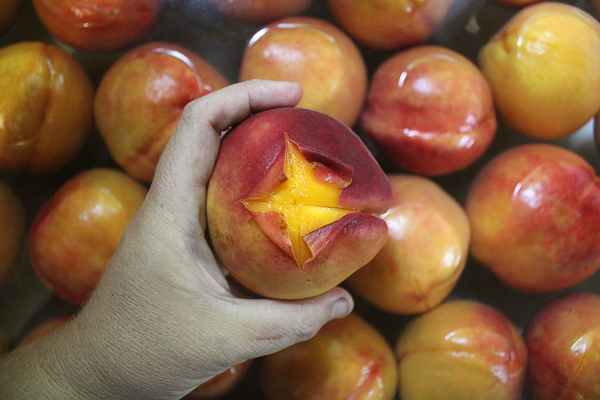
How to Can Peaches
Now that we’ve gone through just about every variation and option available, how do I do it?
In my kitchen, I can peaches in very light syrup using the hot pack method. Most often, I use quart jars because that’s just about the right size for a cobbler to feed my family of 4. Here’s my simple recipe for canning peaches at home, but hopefully you’ve learned a thing or two about how to modify the recipe to suit your family’s needs.
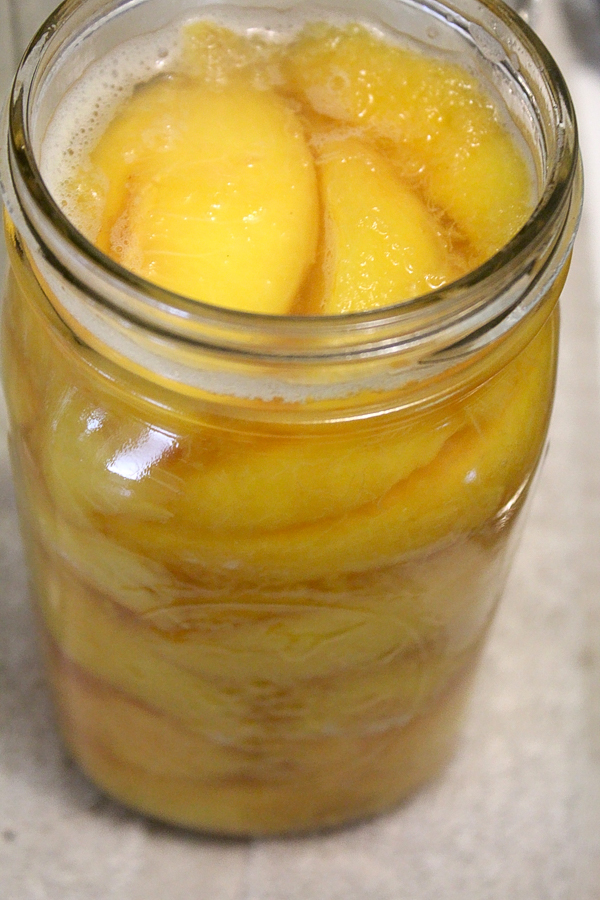
Start by peeling and slicing the peaches. Make a syrup by bringing the right proportion of sugar and water to a boil in a large pot.
For very light syrup, you’ll need 10 1/2 cups water and 1 1/4 cups sugar. Add the peaches into the boiling syrup, wait until the syrup returns to a boil, and then cook the peaches for a few minutes.
Pack the hot peaches tightly into quart or pint mason jars, and top the jars with boiling syrup. Remove the air bubbles, and be sure to leave 1 inch of headspace. Attach 2-part canning lids and process in a water bath canner for 25 minutes for quarts and 20 minutes for pints (under 1000 feet elevation).
Peach Canning Recipes
There are plenty of ways to preserve peaches at home, and these peach canning recipes will keep your pantry stocked!
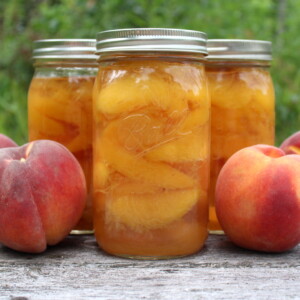
Canning Peaches
Equipment
Ingredients
- 18 pounds peaches
- 1 1/4 cups sugar
- 10 1/2 cups water
- boiling water, for peeling peaches
Instructions
- Bring a pot of water to a boil and submerge peaches for 30-90 seconds. Remove with a slotted spoon and cool in ice water. Peel the peaches with your hands, the skins should slip off easily. If they don’t repeat the boiling process.
- Slice the peaches in half and remove pits. They can be canned as half peaches, or sliced, it’s up to you.
- Bring 10 1/2 cups water and 1 1/4 cups sugar to a boil in a stockpot. Stir to dissolve the sugar. Add peaches and cook for 1-2 minutes.
- Ladle hot peaches into prepared quart canning jars (or pints if you prefer). This recipe should yield a full 7-quart canner batch.
- Top the peaches in the jars with syrup, leaving 1/2 inch headspace. Remove air bubbles and seal with 2 part canning lids.
- Process in a water bath canner, 20 minutes for pints and 25 minutes for quarts under 1000 feet in elevation. If you prefer to pressure can, process for 10 minutes at 5 pounds pressure in a weighted gauge pressure canner. (Use 6 pounds in a dial gauge pressure canner.)
Nutrition
Nutrition information is automatically calculated, so should only be used as an approximation.
Ways to Preserve Peaches
Looking for more ways to preserve peaches?
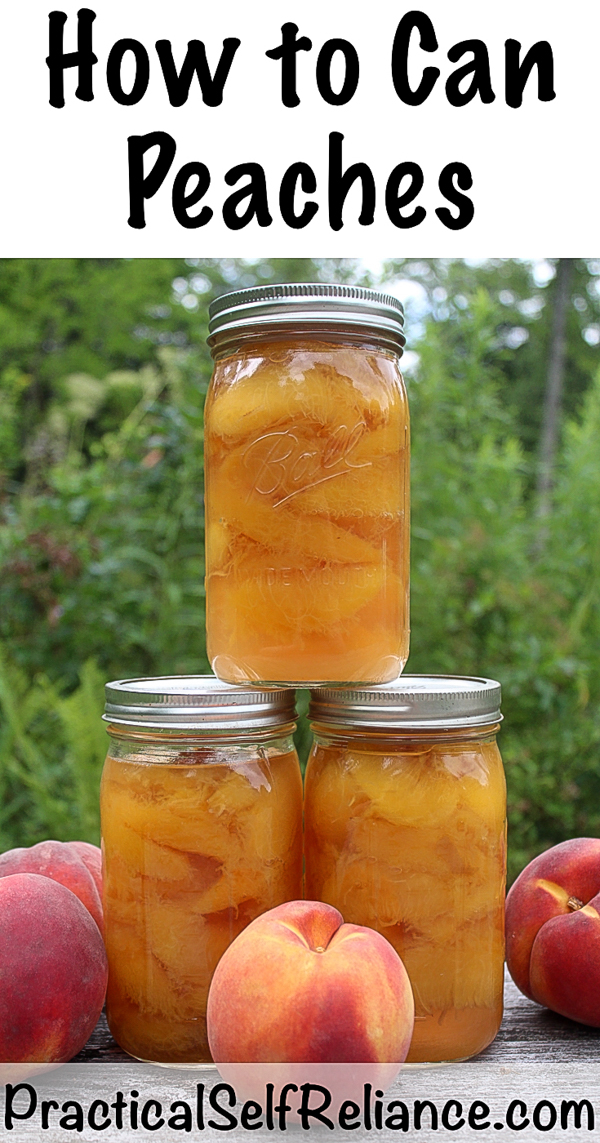
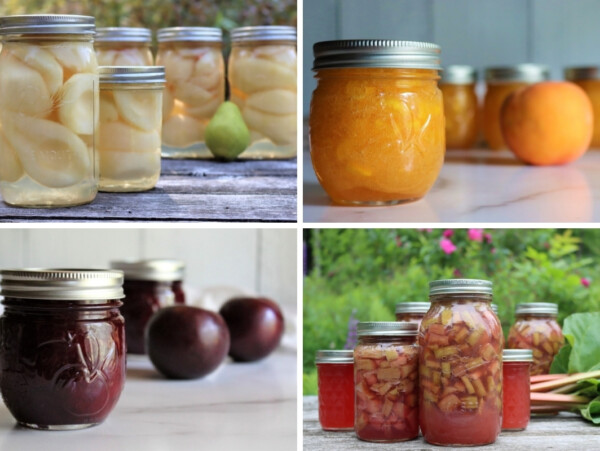
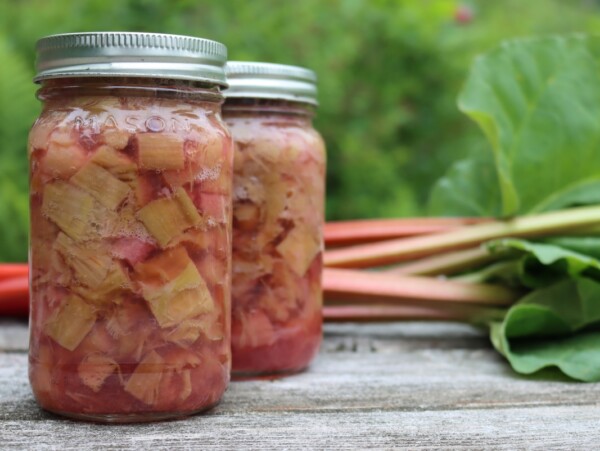
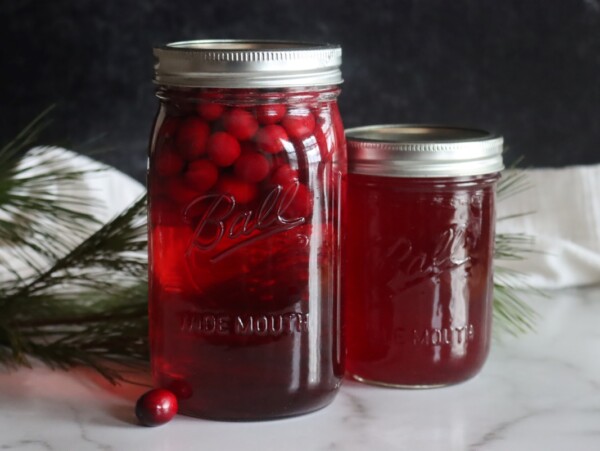
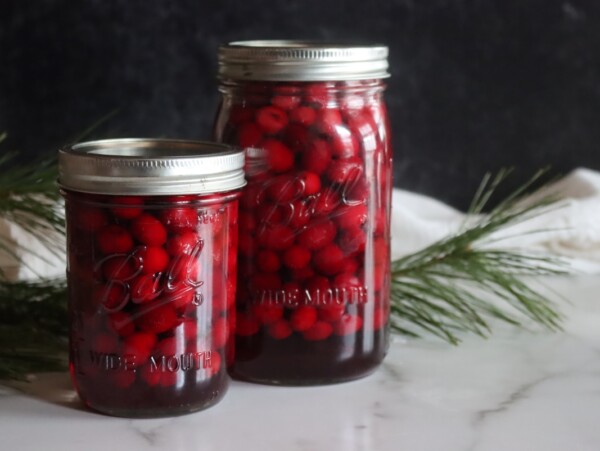
The very light syrup and hot pack method are my favorites for a successful peach canning. Our trees had abundant peaches and now our shelves will have abundant fruit for the winter.
I grew up canning next to my mom. I’ve made peaches my whole life. Haven’t done much canning over the past 5 years and this year I’m back full force. I have gotten so much information from this website. I’ve never hot bath can’t peaches before I can’t believe I haven’t but what a difference. They don’t float they don’t turn brown. I love the idea of honey instead of sugar for my syrup. I am constantly amazed at what I’m learning. Thank you so much.
You are my go-to for good information! Thank you. Am wondering if I can use your method to can peaches with SKIN ON? TIA
It’s not recommended to leave the skin on when canning peaches.
I live at over 3000 ft altitude, and I follow your recipes to a T, including extra processing time based on my altitude. But i recently canned 20lbs of peaches in 750 ml size jars (a pint and a half), and i couldn’t find a processing time for 750 jars, so i split the time difference between pints and quarts and processed for 23 minutes. Would it be ok do you think? The peaches look great, but I’m concerned about long term storage. FYI….The 750 ml jars are almost the same in diameter as the pint jars, just taller.
It makes sense to split the difference that way but there’s really no way of knowing for sure unless it has been tested. I probably would have just went with the longer processing time to be on the safe side but that’s just me.
Purchased a bushel of peaches today! Thank you for the detailed information. Now I’m confident I will have the best canned peaches ever!
Thank you for this awesome info! Question…i water bath canned peaches last summer and used a raw pack method. However…I did not boil the water (i have a reverse osmosis water, if that helps in any way to know that lol!), but filled the jars with the peach juices and filled the rest of the way with water. Water bathed and they all sealed. There has definitely been discoloration, but now I’m nervous to eat them. Did using cool water make any difference in the food safety? Thanks!
You can’t be certain that the food was safely processed unless the instructions are followed exactly which does include boiling the canning liquid. If you’re using cold liquid, it takes more time for the food in the jars to come up to the appropriate temperature for processing.
I water bath canned some peaches this year I went to open one it didn’t seem to be sealed very hard they smell fine and look fine are they still ok to eat?
What do you mean they didn’t seem to be sealed very hard? If they weren’t sealed properly, I wouldn’t eat it. Food that is improperly canned may look and smell fine but may still have the potential to make you sick.
I will say you make canning for a first timer, like my wife and I as easy as it could possibly be. With all the information you lay out… We did the recipe exactly like you said, 18lbs of whole peaches, we ended up with 8 quart jars full.. We also had some brine (if that’s what it’s called) left over. Hopefully I did it right. Thanks for all the Information!
Sounds like you did great! So glad it was helpful for you.
I just read that using Pickle Crisp(Calcium Chloride) improves the texture of canned peaches. The site does not say how much to use so maybe the same amount as when canning Dill Pickles? Have you ever heard of this?
Yes, I have heard of it being used for that before but we try not to use any unnecessary additives in our canned goods.
I have a question about checking the seal on a jar. I can pick the jar up by the edge of the lid so I think it is sealed. However, when I tap the lid with a spoon I get a “thud” sound instead of a “ping”. Not sure if that means anything or if it thuds because I raw packed the peaches and they are floating. The peaches ins the jar are touching the lid. Are these jars of peaches safe to eat?
Are you able to push down on the lid? Does the lid give when you push on it or is it solid?
Bought a 1/2 case.of peaches in GA on my way back to FL from IA. They are all pretty ripe so was planning on blanching, peeling, slicing and freezing (with a little lemon juice to keep color). I want to try canning some and need to get supplies – do you think these frozen peaches can be cooked / hot pack and canned with good results??
I’m not sure that the texture of the peaches will hold up in the canning process after being frozen.
I never blanch my peaches before freezing . I peel, put citrus acid powder from Ball and do a thick slice. Always come out excellent!
Do you can them after you have frozen them?
No I don’t can after freezing. I use most of them for breakfast. I break away the amount I want into a bowl, put in the microwave till defrosted. They’ll probably be slightly warm but still have a bite to them, mix with plain yogurt, YUM!
OR make crumble, cobbler. Just put in baking dish fully frozen and add what you’d like.
Yes, they can definitely be frozen for use later on without affecting the texture but I believe that Lori was specifically asking about canning the peaches after they had already been frozen.
I like to use cling stone peaches when canning, but I cut around the stem, twist open, remove stone, and peel rather than blanch to remove the skins. Cling stone peaches are firmer and do not become as “mushy” when canning.
I do like to use free stone peaches for freezing.